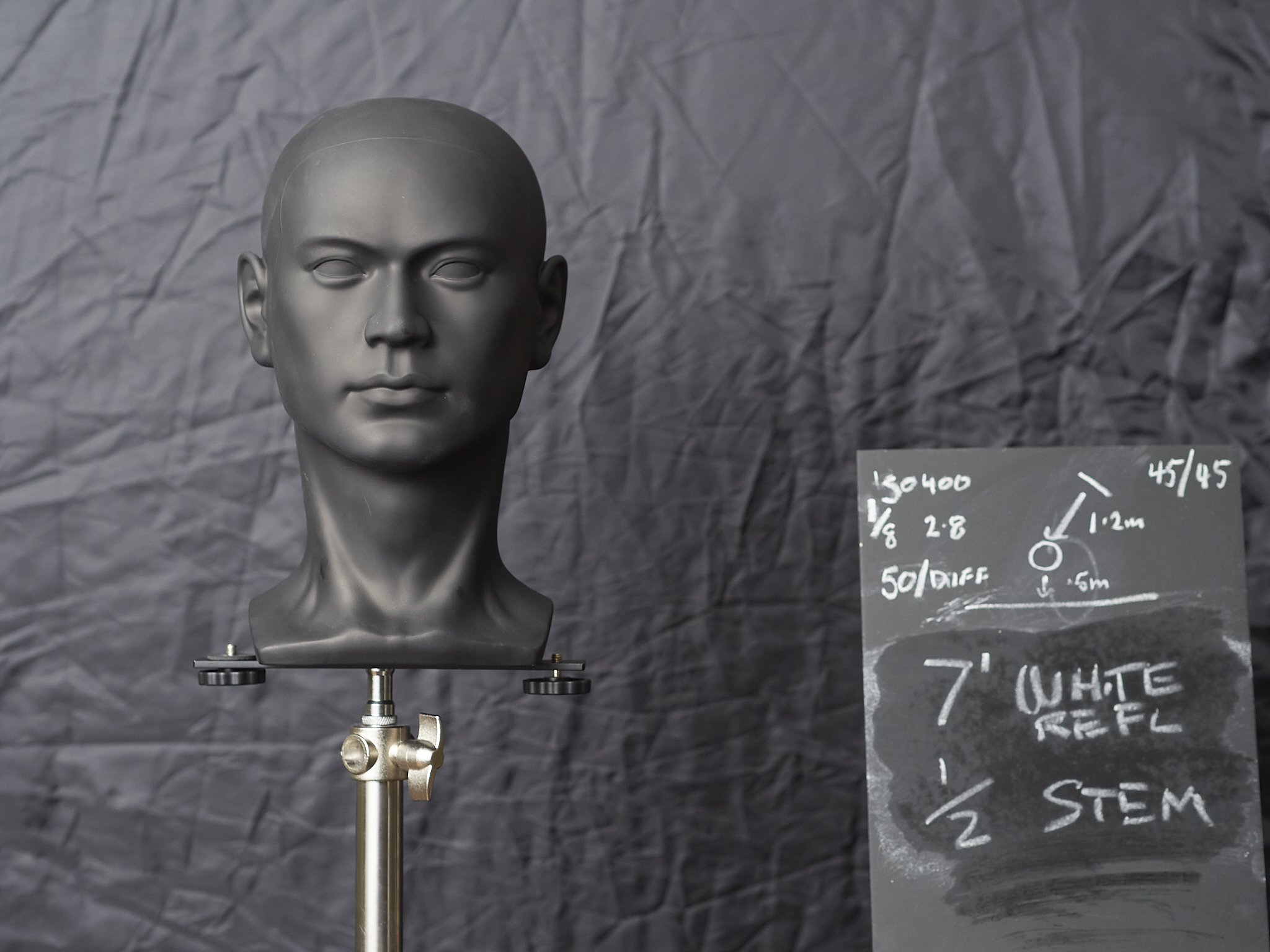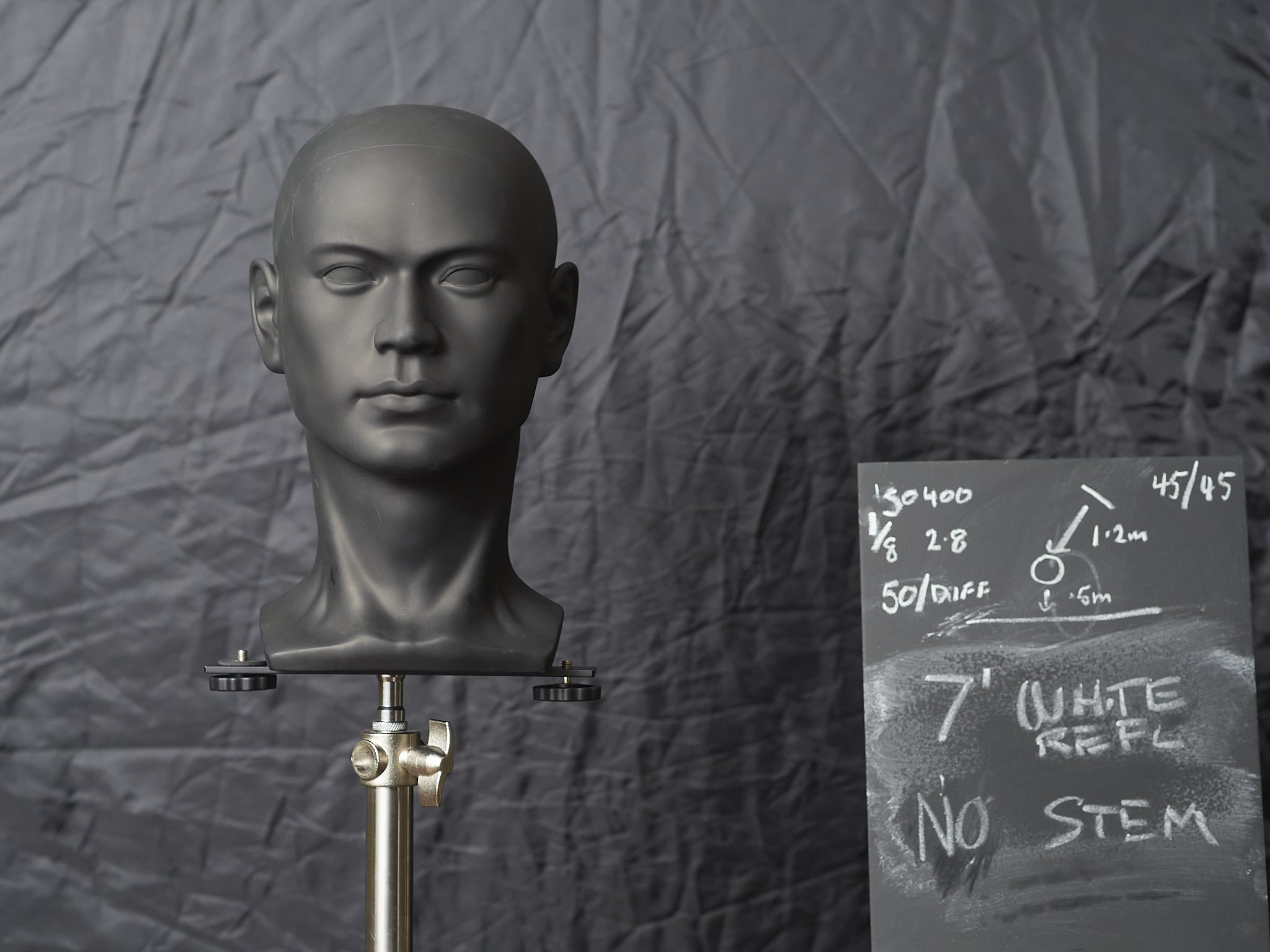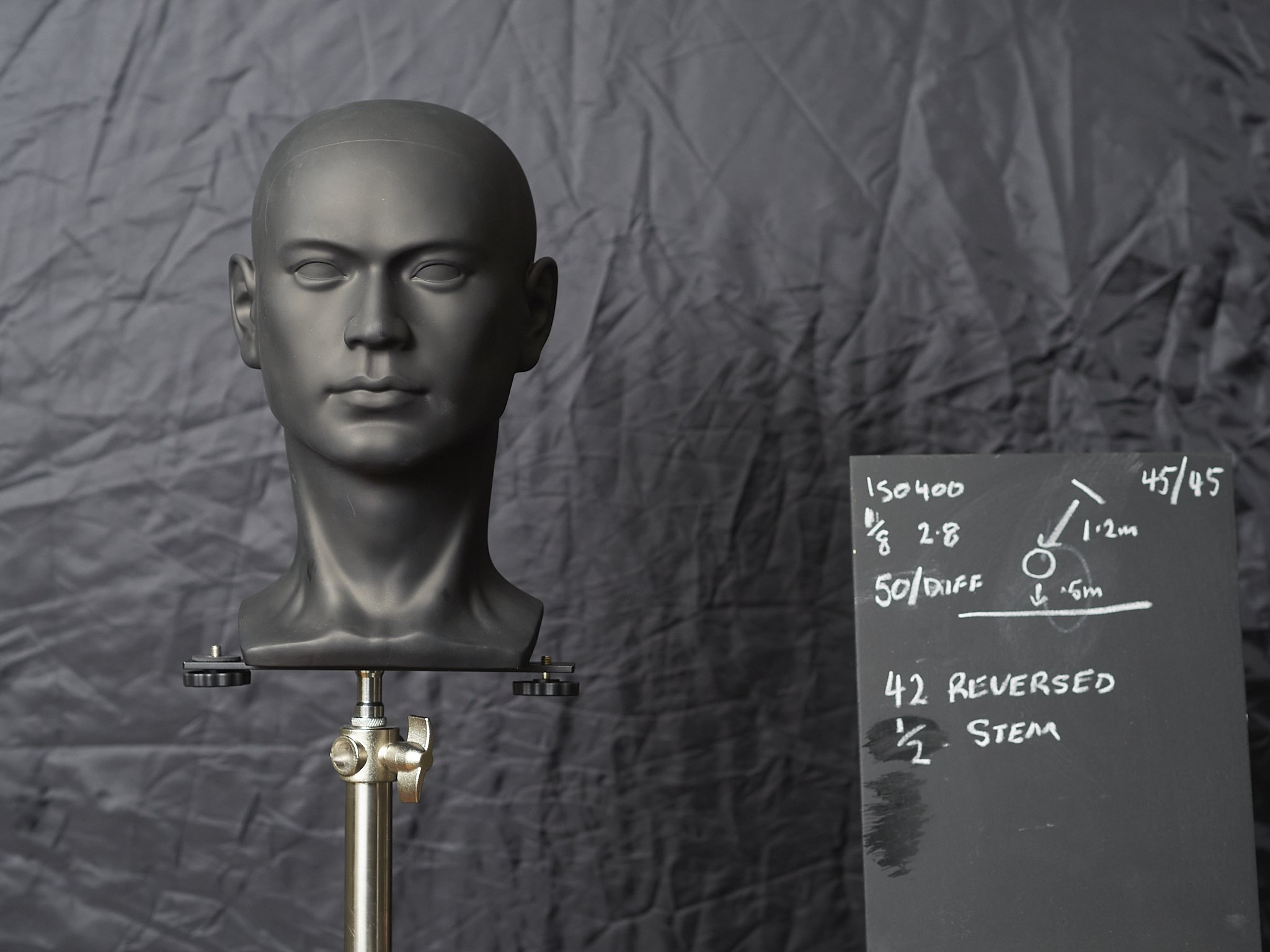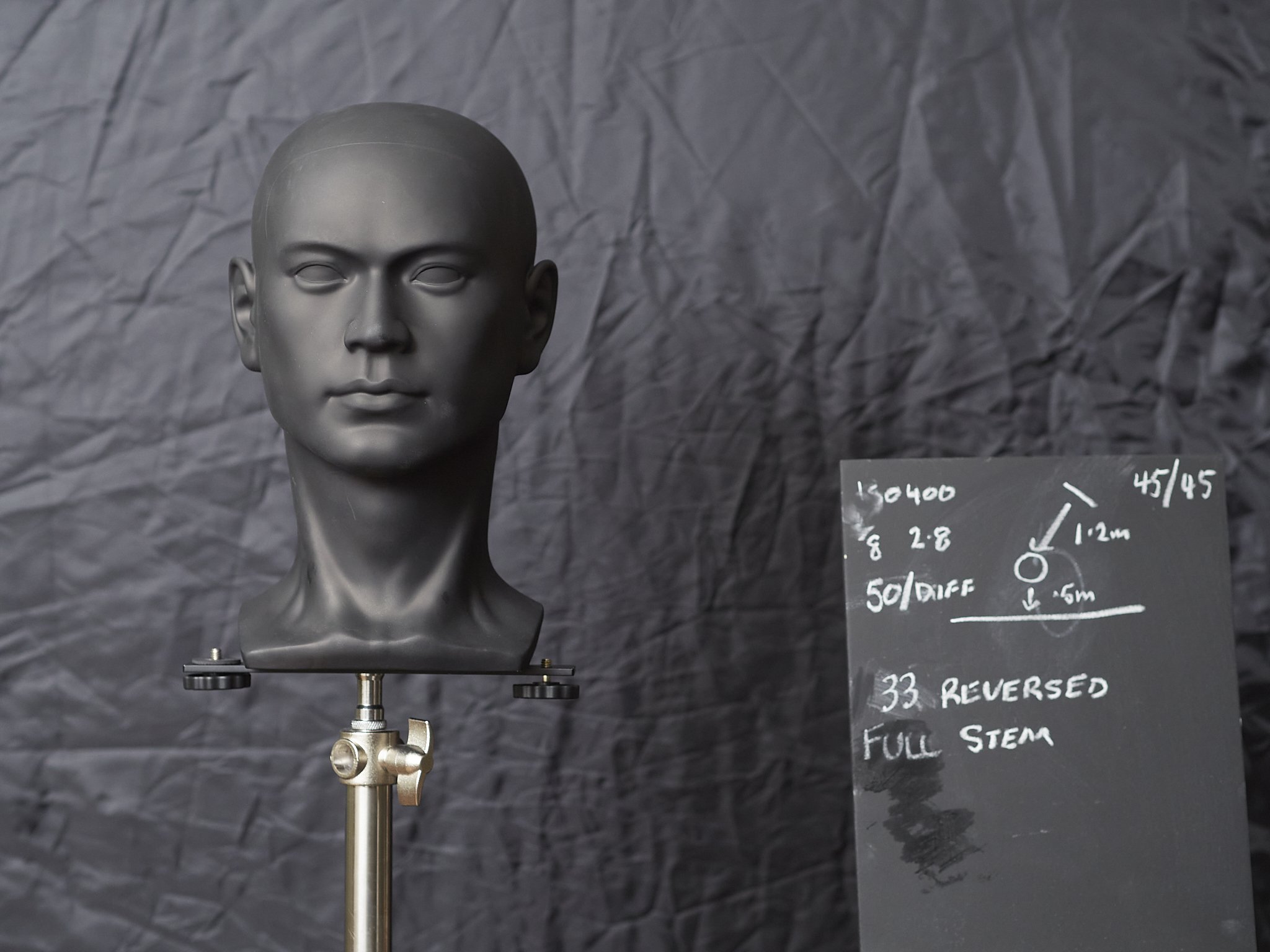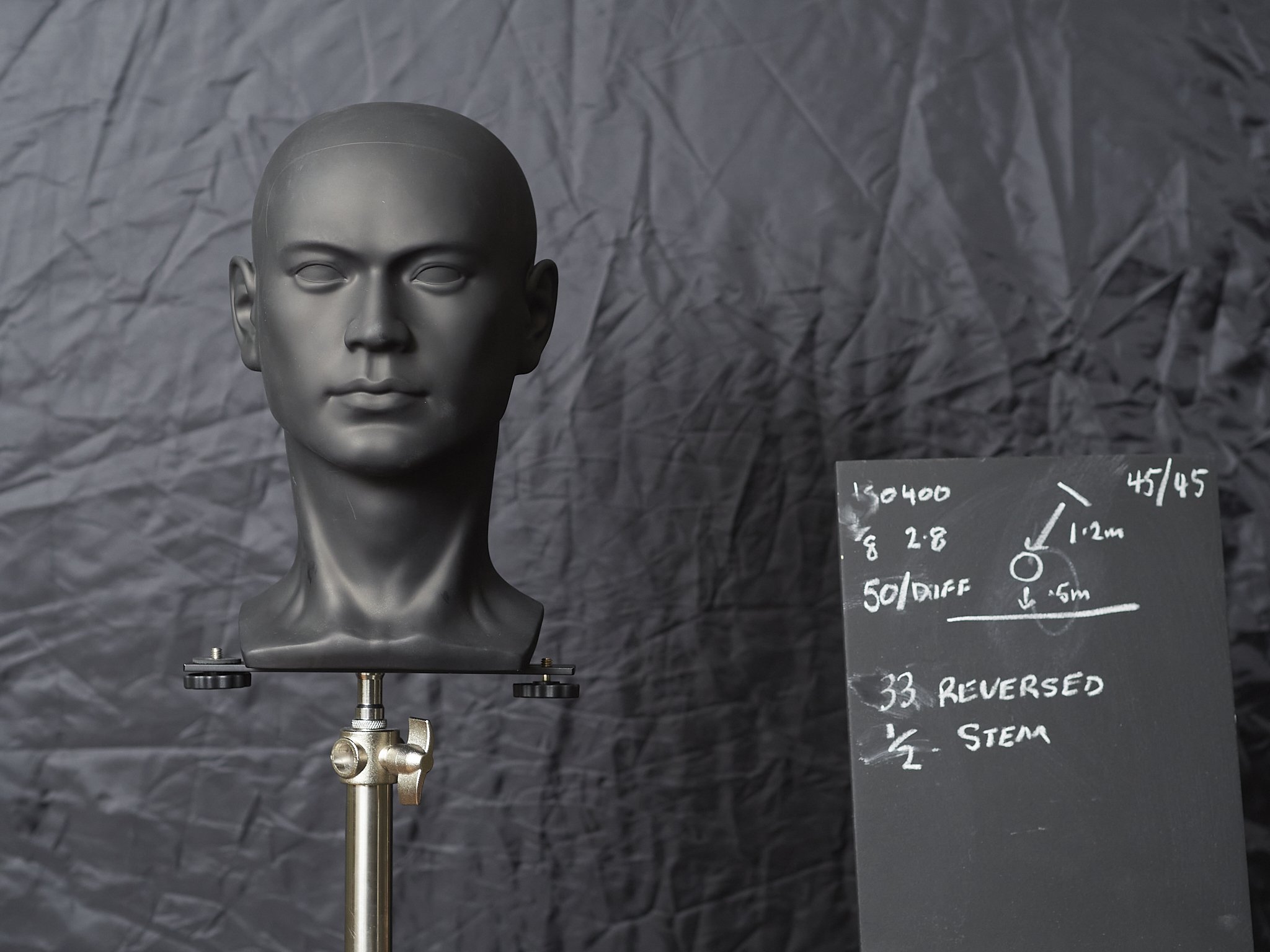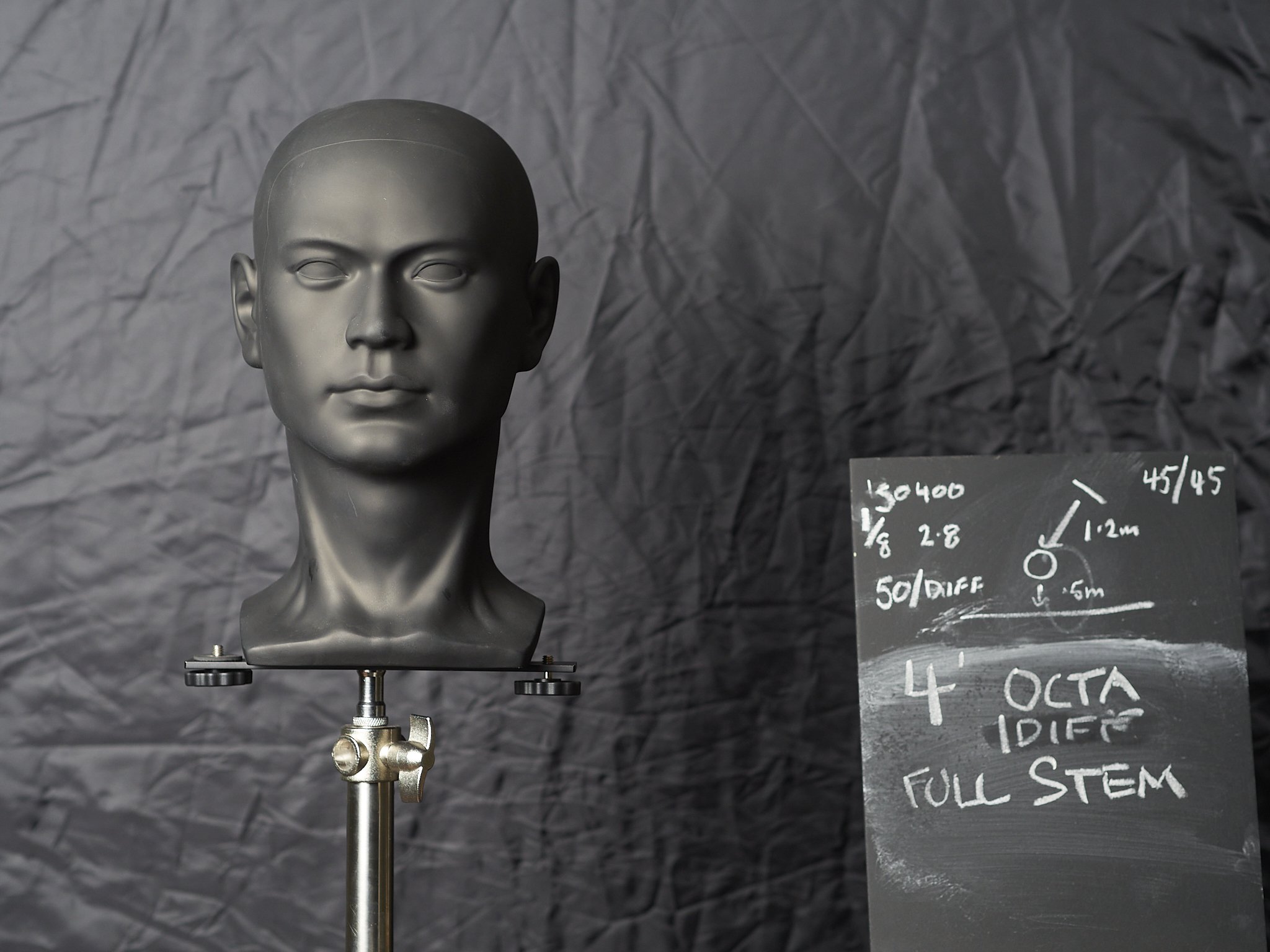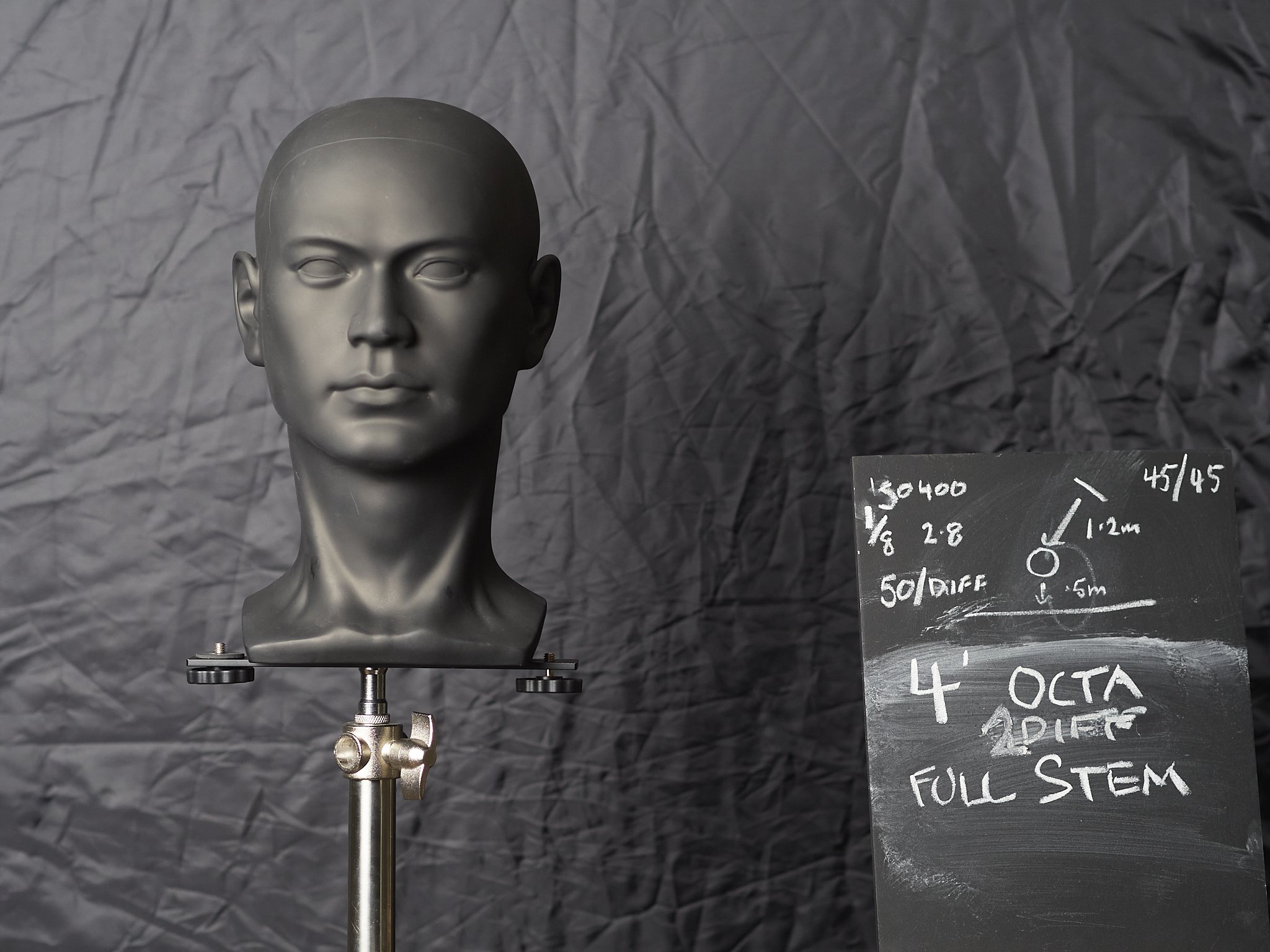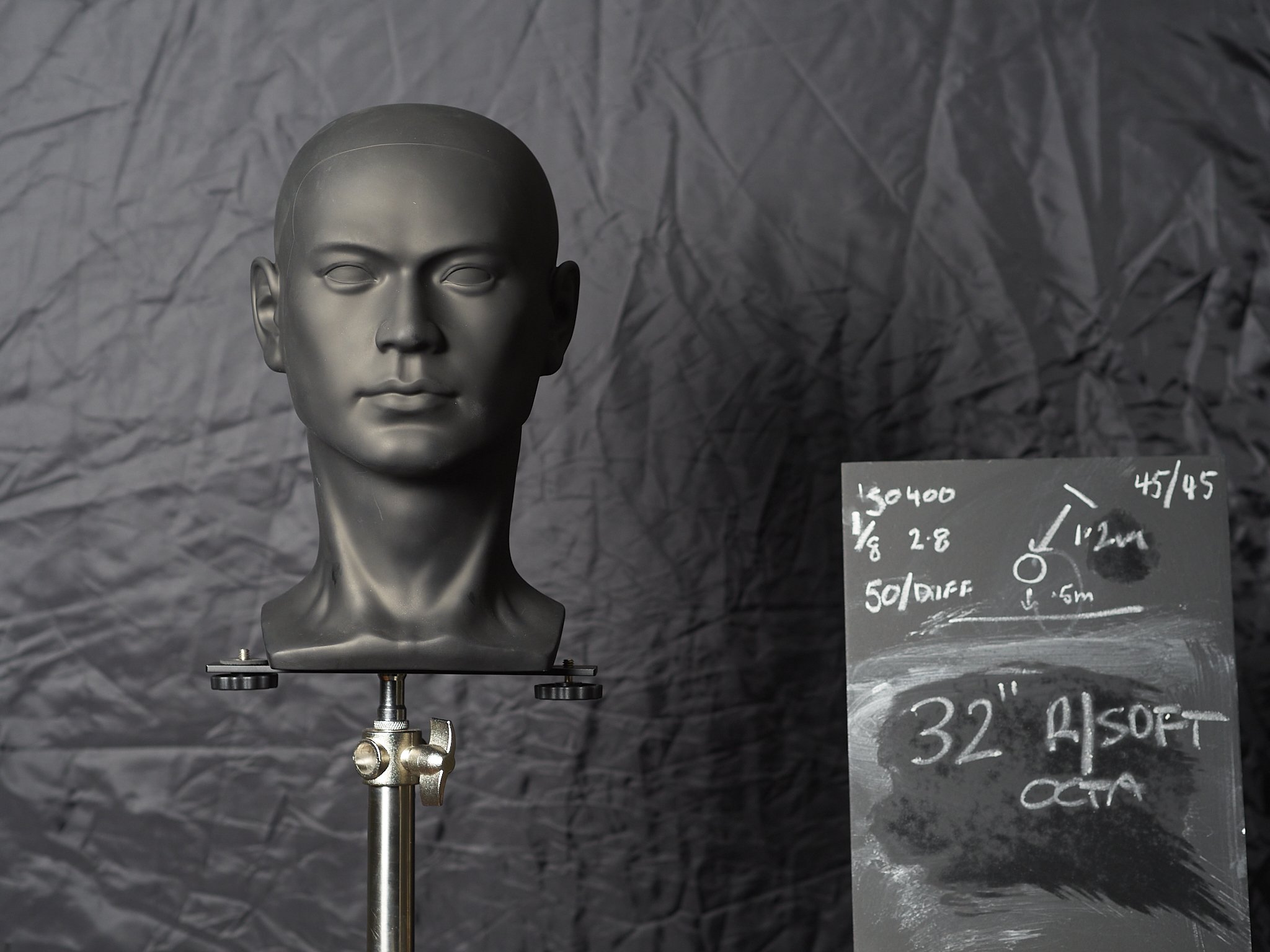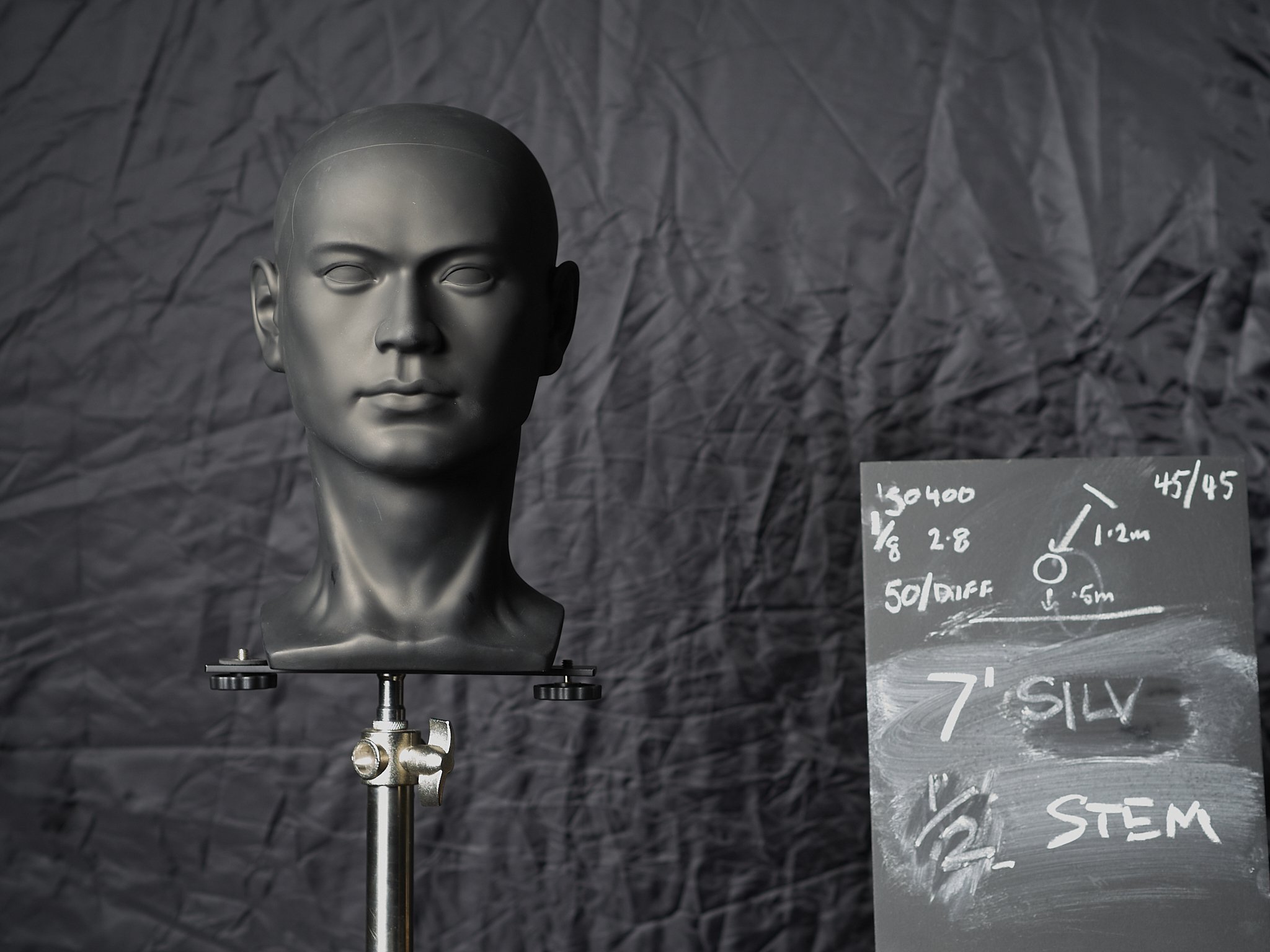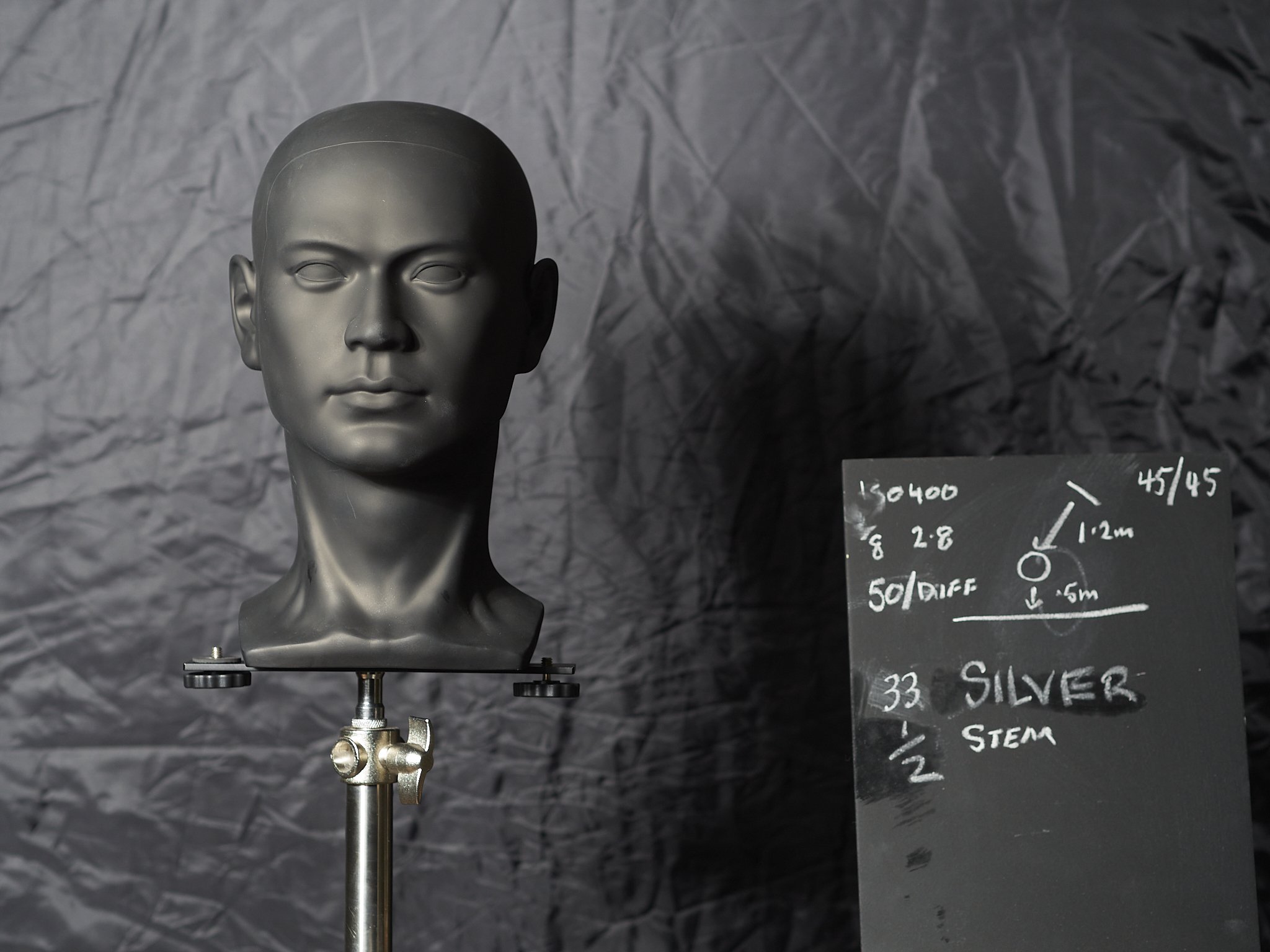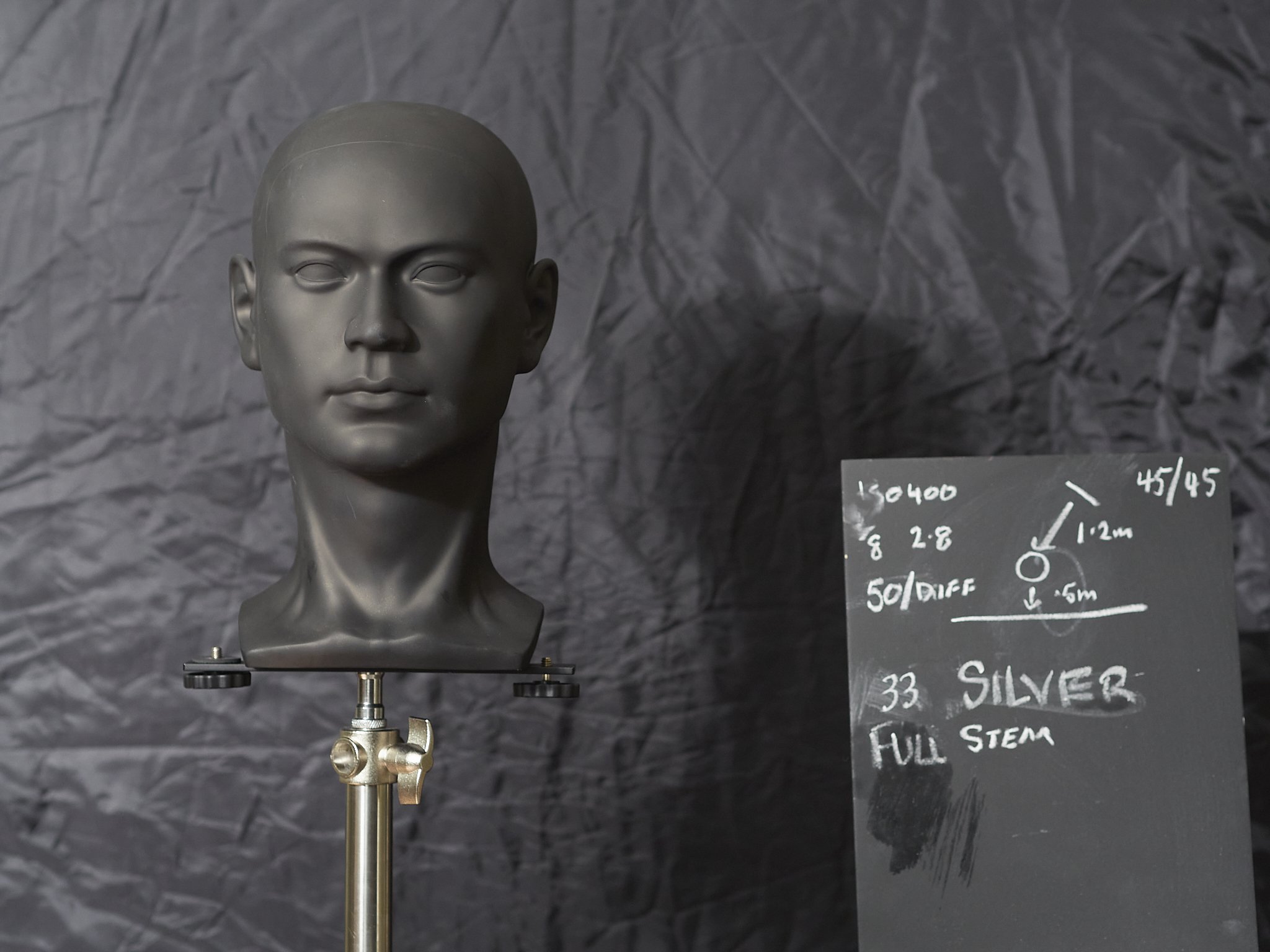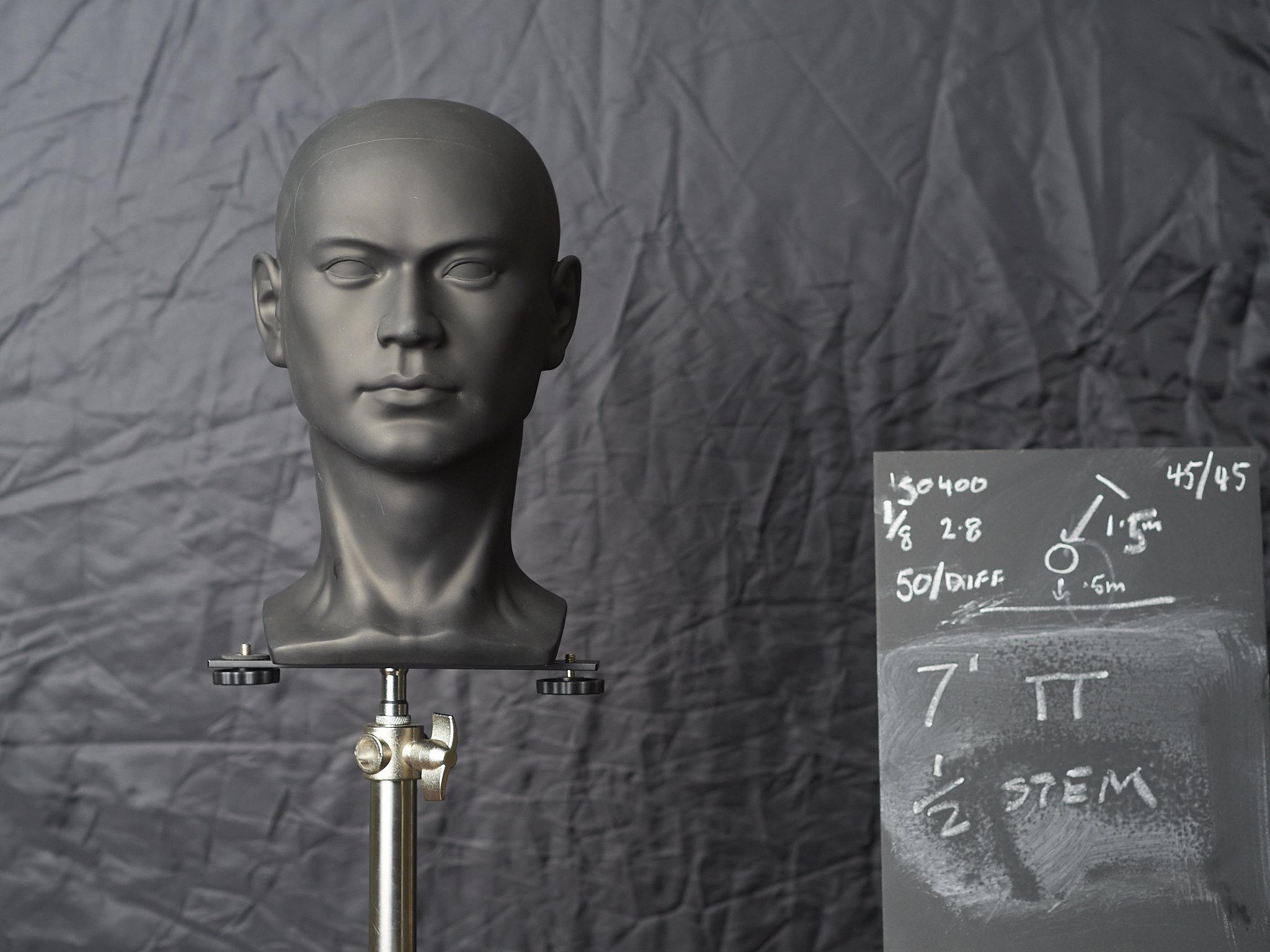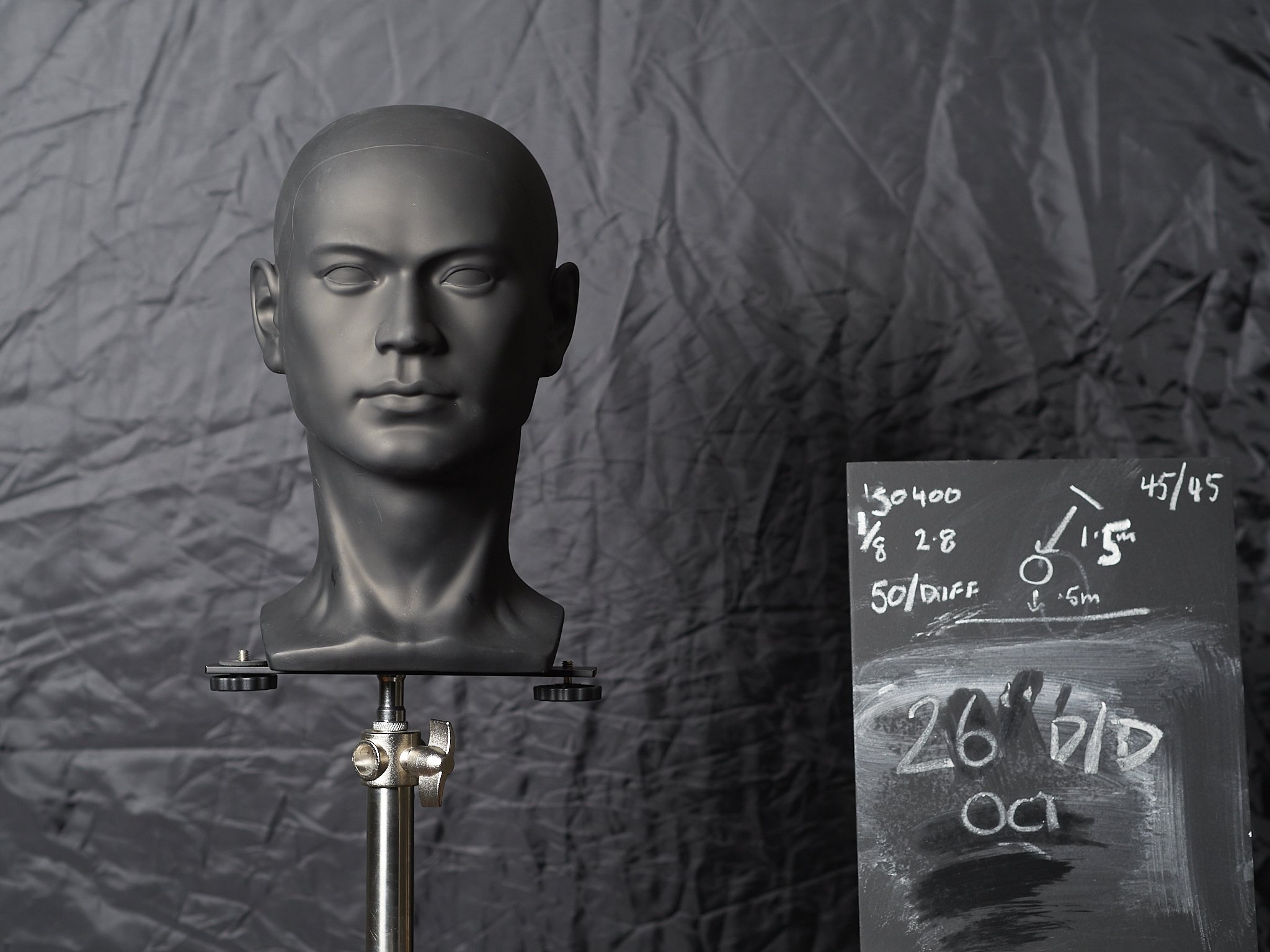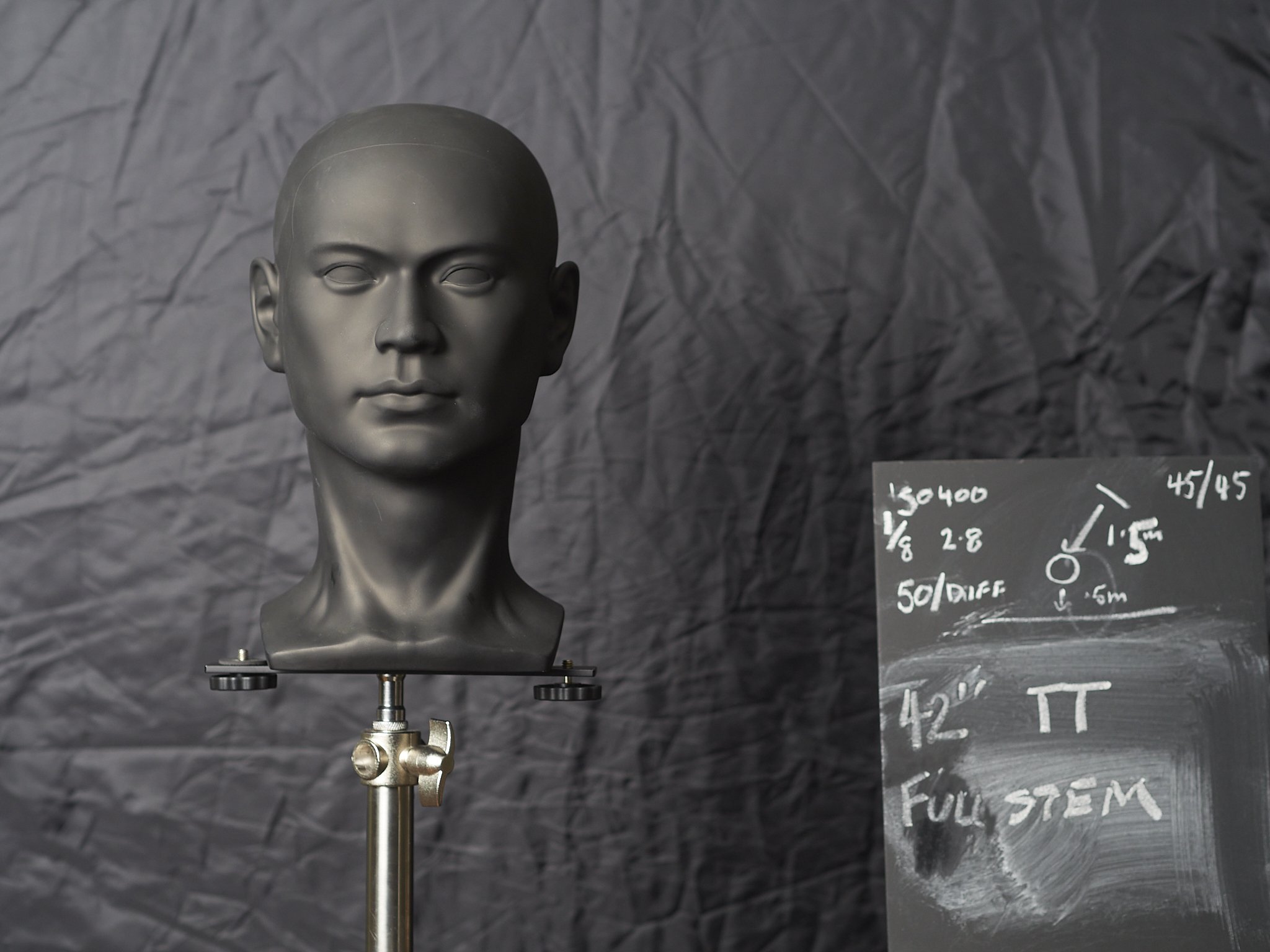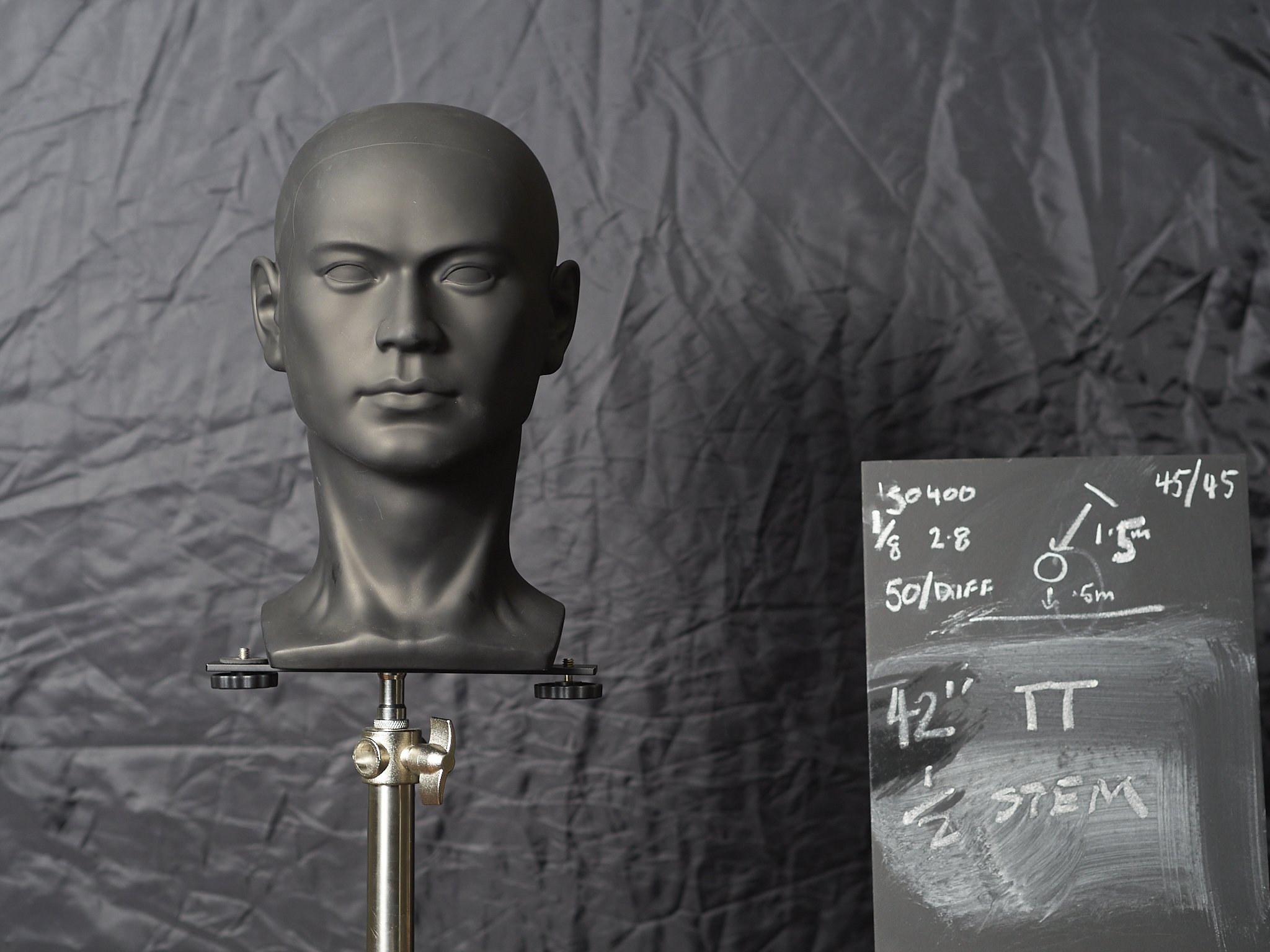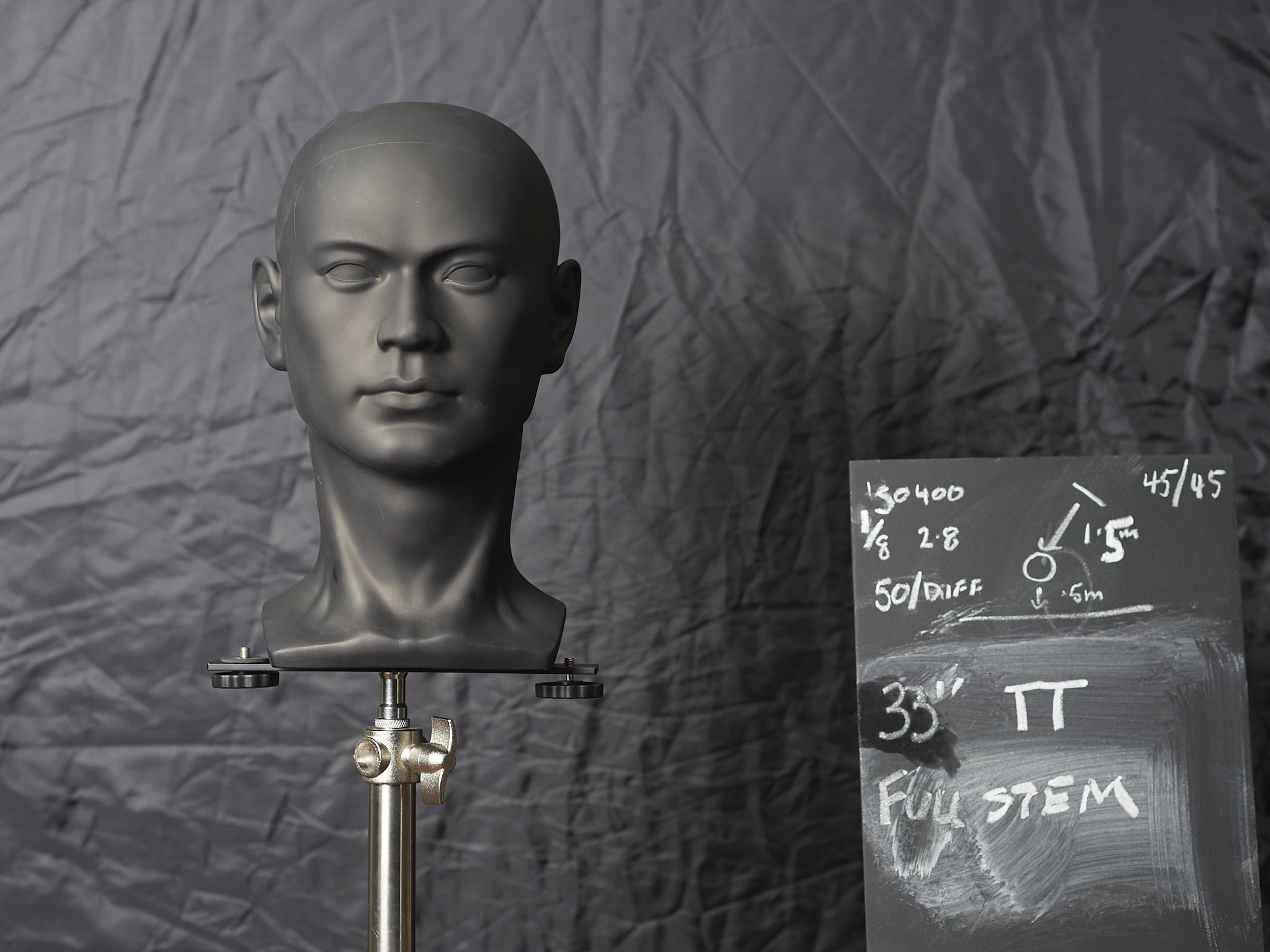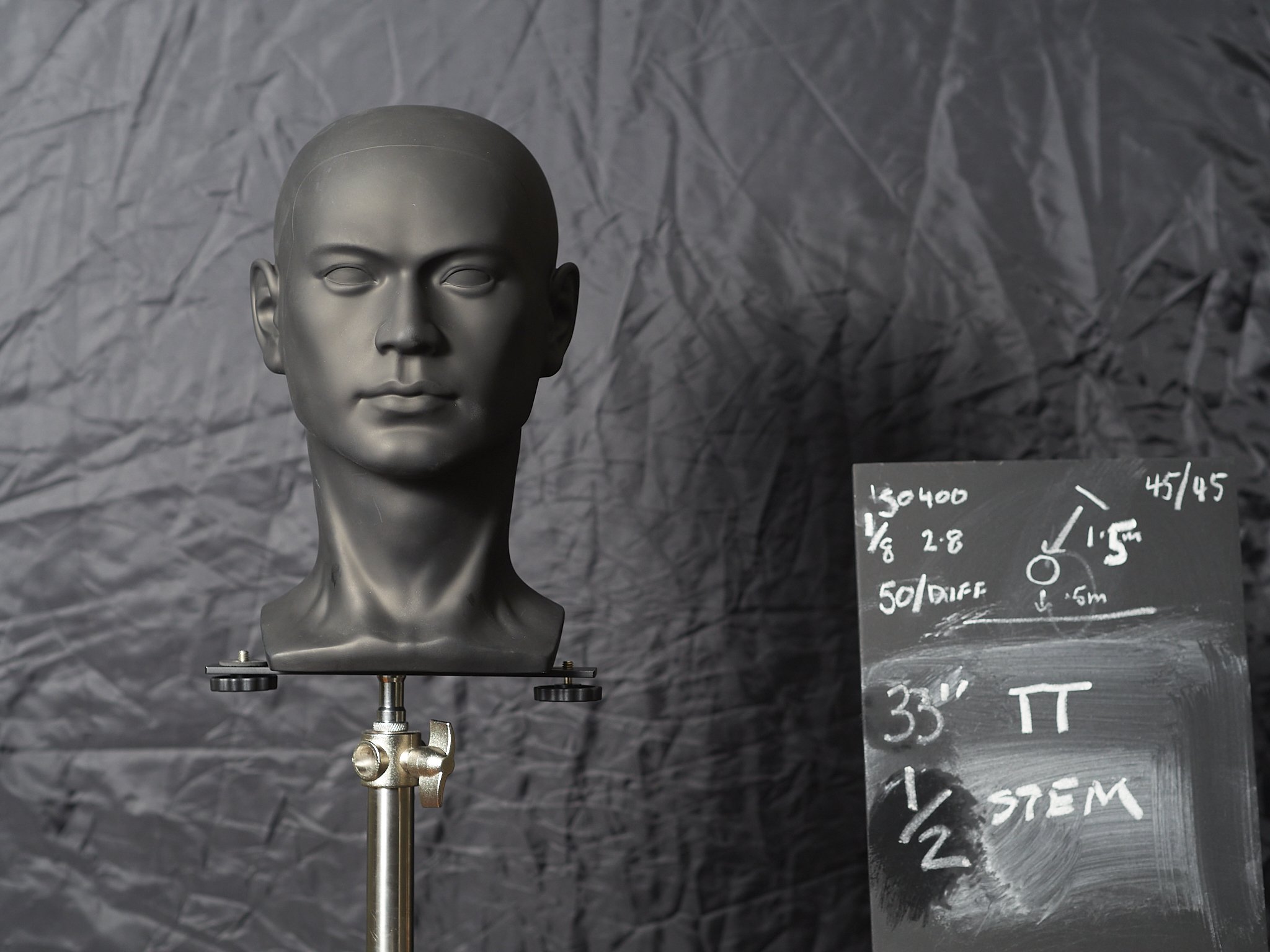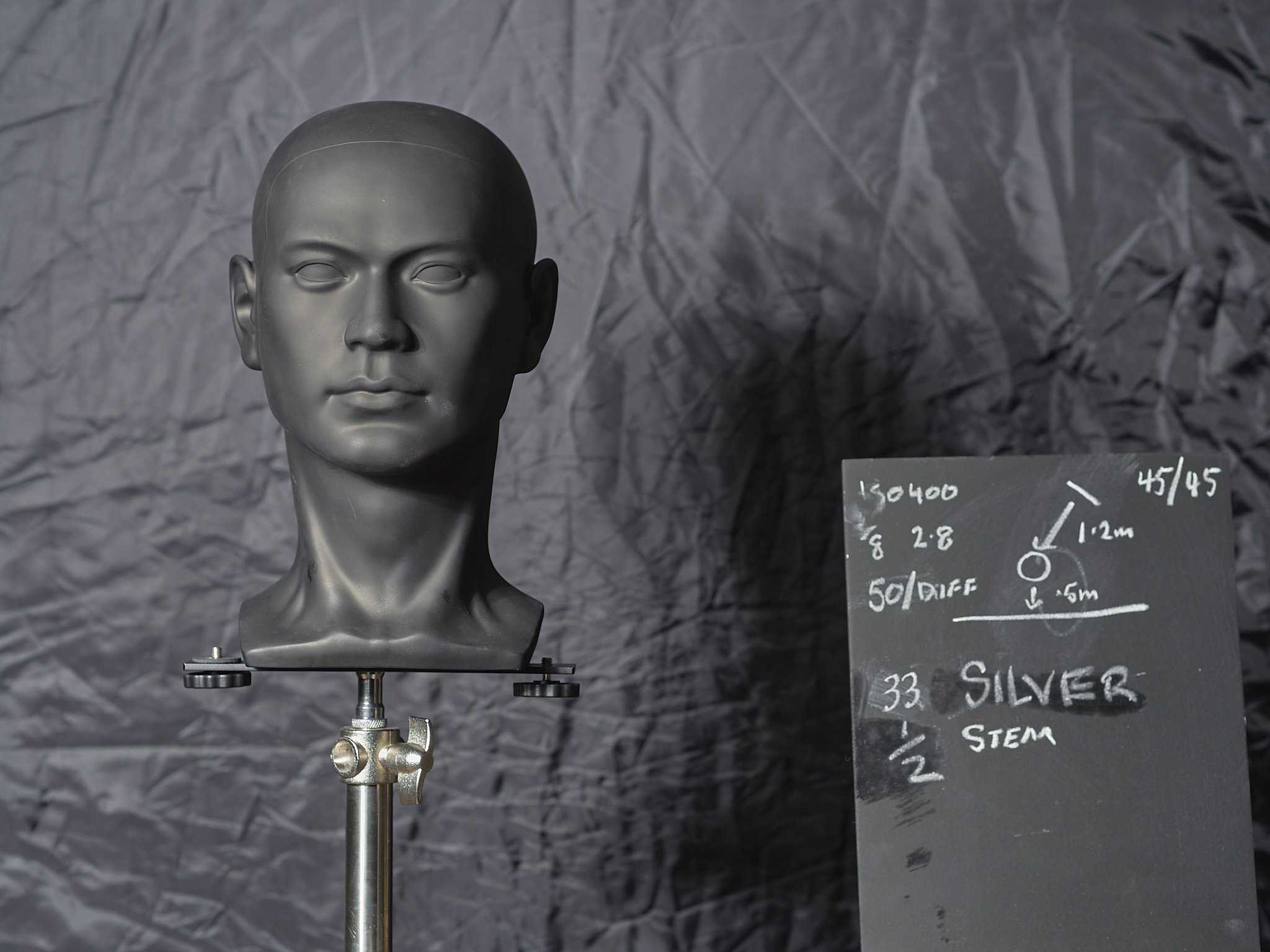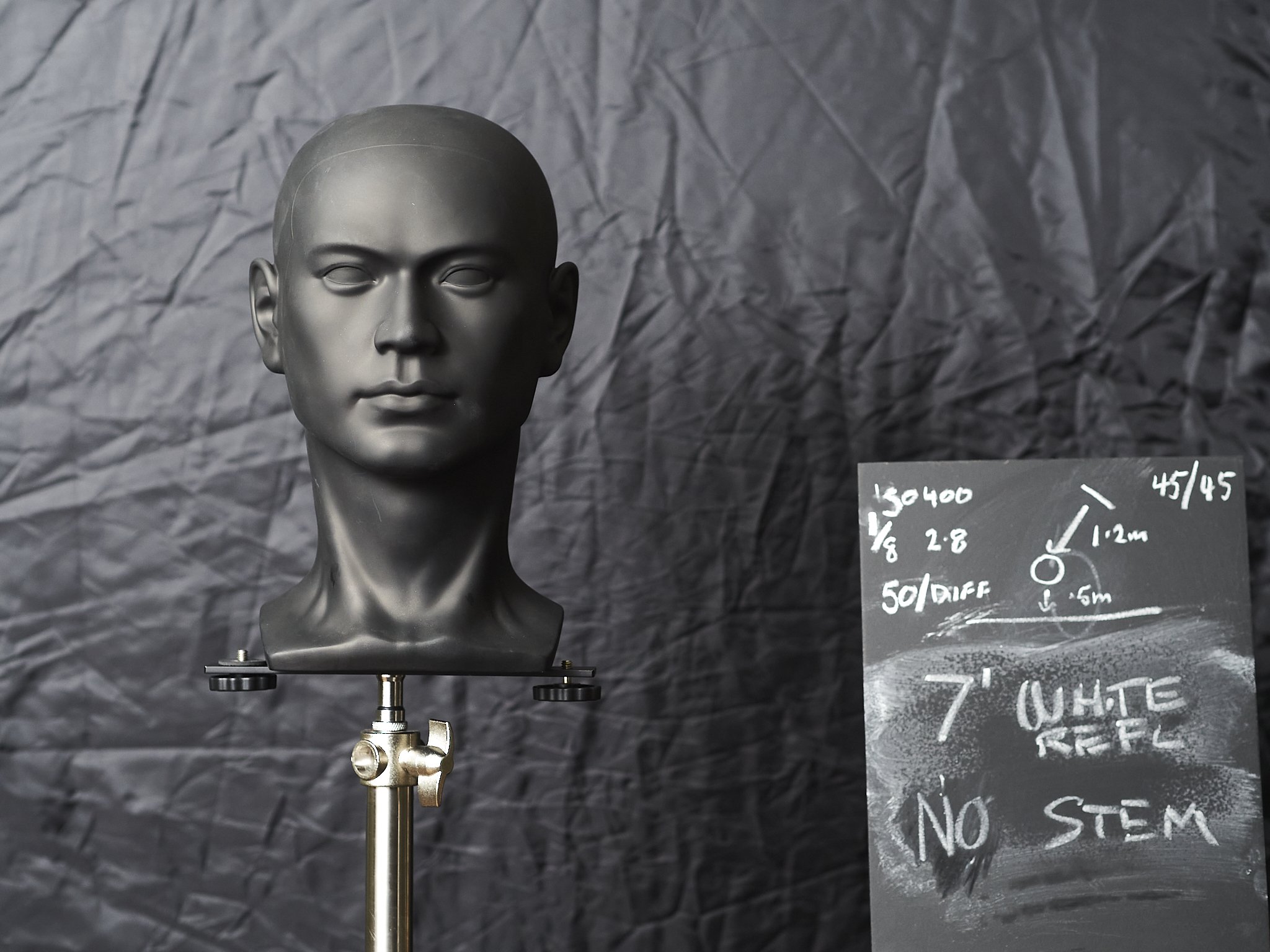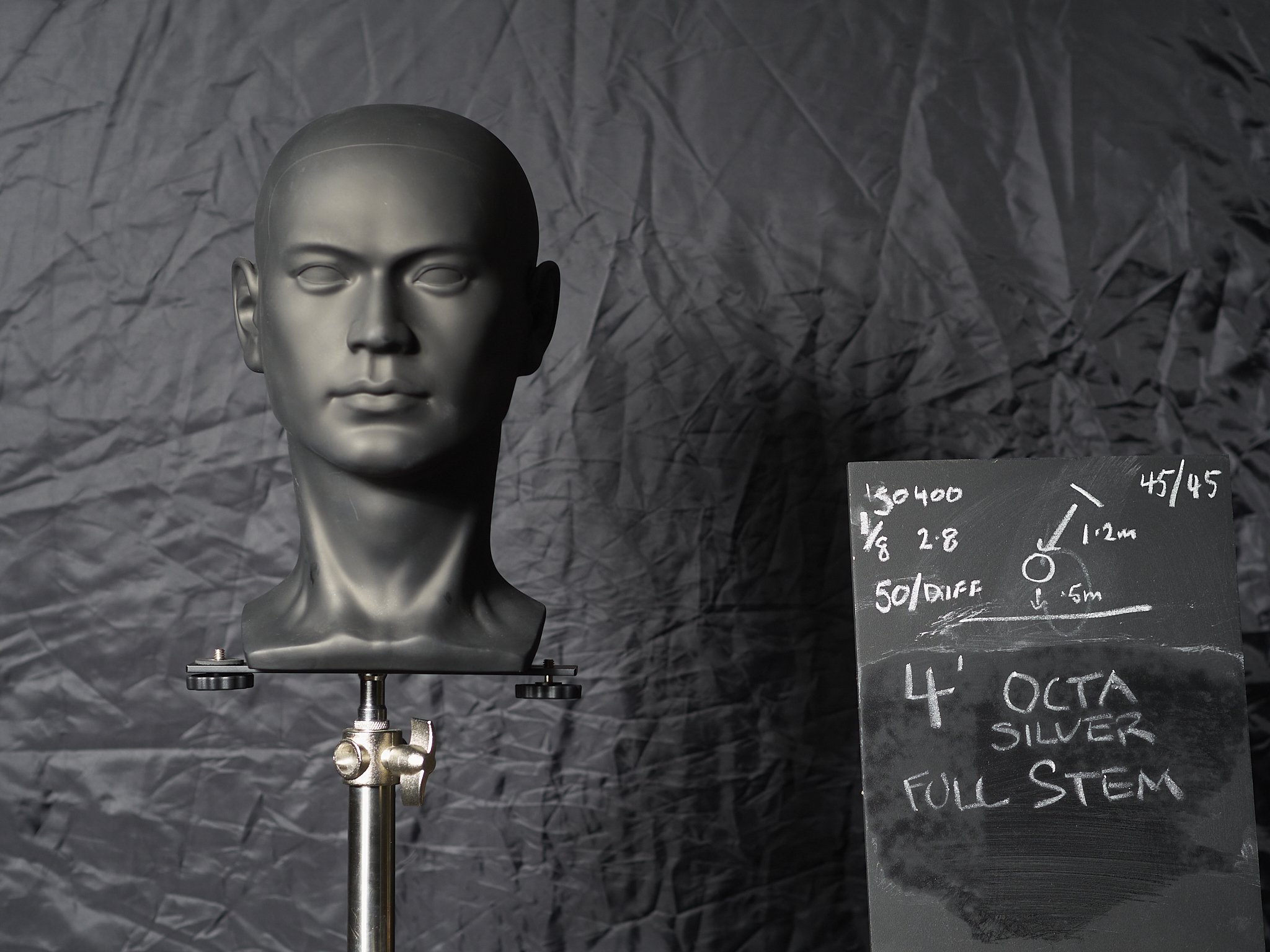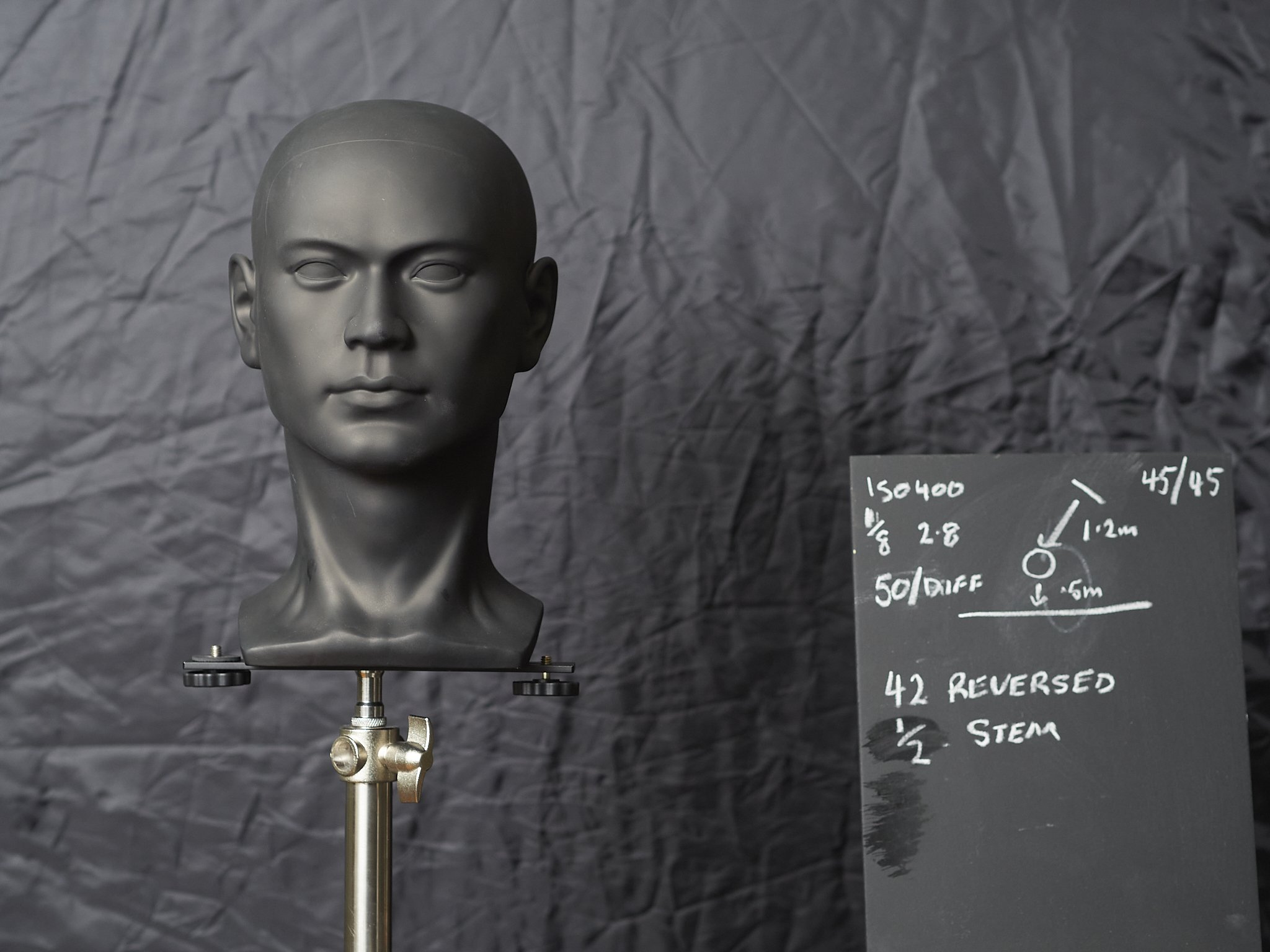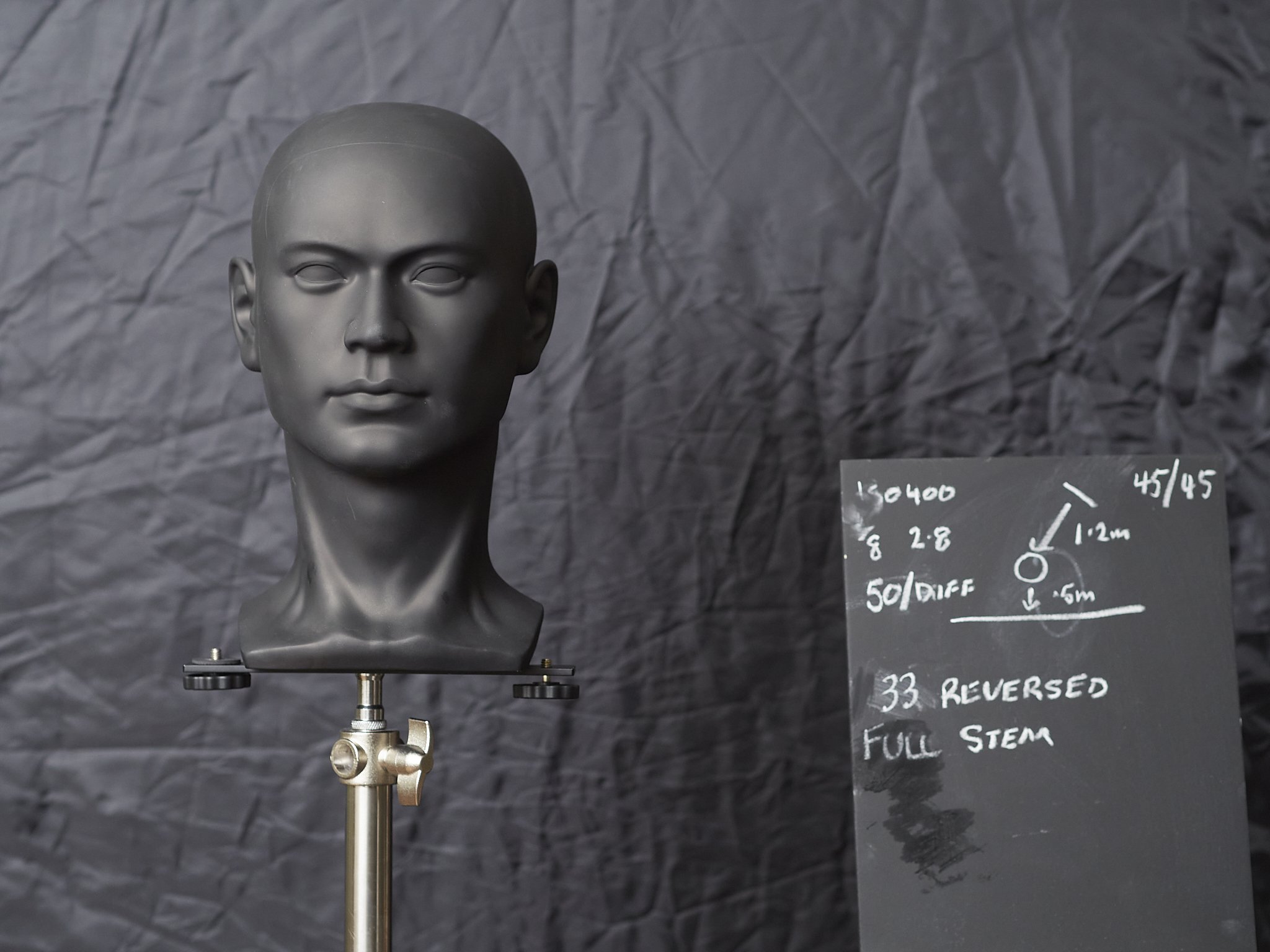The last test had no porcessing applied, to test both look and light efficiency. This group of files are the same ones, but roughly “normalised” by eye. the intention was to get the right brow of Joe Black roughly the same or at least how I would want it if processing.
First up, my favourites, reversed white (and translucent) brollies. The things to take note of are the shadows on the fabric behind “Joe”, which is 20”/50cm away, the shadow hardness from the nose onto the right hand cheek and the transition around the right side of the face (i.e. can you see any ear detail).
Of less interest is light colour, but it is something to take note of.
Reversed brollies always seem to produce the most gentle/flat highlights regardless of other elements in the image.
The no stem 7’ white is clearly softer and more open, but all are pretty soft and the difference between the 42” and 33” is slight other than their colour difference (the cheap Neewer 33’s are stark white, the Godox 42’s warm white).
Pulling the stems in to half way seems to soften their effect, making more difference than the brolly size does. The stem move seems to match the sive above at half stem.
All of these seem to treat the background evenly.
Main take away; Stem position has the same or more effect than changing size of mod.
*
Now for reversed brollies with diffusers. These are effectively “double” diffused.
I find it interesting that even with an effective extra layer of diffusion (bounce), the silver base of these mods still makes them contrastier and more efficient than the brollies above.
The 43” looks closest to either 4’, with the 32” harder overall, the price of being 2/3rds the size, while still being in the same ball park, and it seems quite even over the background and is quite efficient.
Main takeaway; These run hotter than reversed brollies even if double diffused and bigger.
*
Bare silver now, the most brilliant of surfaces.
The 7’ silver manages to effectively remove the rear shadow, but still shows strong and clean contrast on the subject. It is also clearly more even over the whole background.
The 4’ is more open across the face, even though the rear shadow is quite defined and the side shadows are possibly deeper.
The 33” brollies have defined rear shadows, but slightly more open faces (the angle changed slightly due to the size of the 7’ brollies), except the oddity that is the full stem 33”. This is acting like a larger, whiter mod on the face. I suspected I mixed this up with the 33” white sample except that the rear shadow is much harder. I was tempted to lighten this a little more, but looking at the chalk board, it is already lighter than the 1/2 stem image.
The difference in warmth is strange also as they all look cold silver to the eye. This may come down to invisible things like the quality of the backing. Something the top end mods seem to have is a deeper, truer backing.
The 33” 1/2 stem I think wins hardest light overall with the hottest background side.
All of these mods were at least a full stop brighter than any other mods tested, some as much as 2 1/2 stops.
Main take away; Use these for hard/brilliant images only.
*
Shoot through now
I find shoot through brollies are harder looking than reversed ones. The look reminds me of the difference between white and silver mods compared with shoot through/silver showing hotter highlights. The rear shadows are harder, but quite small and the highlights a little more brilliant.
The 1/2 stem versions look softer than the full stem, reversing the effect to the reflected application, which makes sense I guess.
Unlike the reversed images, the shoot through seem less even across the background, the 33” especially.
The 26” is added here as it is technically a shoot through, just double diffused. This one continues to impress, consistently coming in as a perfect middle ground, neutral option. It is in the ball park of the huge 7’, which wins overall when reversed. Unlike most of the mods here, it can also be gridded.
Main take away; I don’t like shoot through as much as refelcted for these mods. If I want this look I will likely use a 4’ silver.
*
Softest?
The king of soft, the Neewer 7’ white has two personailites.
Shoot through, it’s pearl finish warms things up and opens the face the most, but reversed it is more neutral and controls highlights better. The reversed version is better to my eye, but it’s nice to know I have options.
*
Can the extremes be bought into line, that is to say, does it matter with some post applied?
Opposite ends of the spectrum. Considering the vast differences in mod type these represent, they are not completely different in reality. A bit of post (right hand two) can easily change the tonality of the files close to the opposite extremes, but it can not as easily change the light spread or “shape” of the image, nor the background spread.
What this does show though, is that post processing can bridge at least half of the gap in real terms. The softened 33” silver is close to the softest and most open I have shown here, almost to the point of being bland!
Note the slight difference in angles was forced on the testing process by the sheer size of the 7’ brollies. They managed to touch the ceiling and at the same time encroach on the shooting area.
Favourites?
I intend to use the 4’ octa as my work horse mod. Small and well enough designed to be easily applied, big enough to be soft with good coverage, numerous enough to be powerful when needed and versatile enough to be the “one mod” for any job. These are even strong enough to be diffused further, so very versatile.
They do seem to have a hotter side compared to most other mods, even some smaller ones, so placement and fill will be key. The Godox ones (not tested), look to have less briliant silver lining, thicker diffusion, slightly less deep shape and grids, so I will compare them all when I get the studio space up and running.
The 42” is softer, but over a stop less efficient, spills light and is unusable outside. The difference falls within post processing tolerances.
The 7’ white is also softer overall, but the 4’ has more clean brilliance and is safer-easier to use, especially outside.
Used as a deep silver brolly, this is the most efficient mod I have, making me excited for the potential of 4 of them used together!
The 7’ silver is also very strong with more open shadows, but is harder to use and I have and can use one only due to C-stand and space requirements.
The 4’ consistently produces a more focussed shape on the face and stronger background shadows, sometimes more even than smaller mods, likely down to the deep parabolic shape. Focus is good though as shadows can be recovered, but stray light is hard to fix.
I can also grid two of these making them even more focussed than almost any other mod I have.
Other options available to me are to change the flash head diffusion to white domes rather than the drop down transparent panel, change the head spread from 50mm to wider or tighter, change camera and most importantly processing settings or even try some internal baffling.
If I stay determined to master these, or any other mods, I think they will be able to do anything I need, even with tons of other options available.
Still my two sentimental favourites. The awesome value that is the 33“ white translucent ($10ea) for soft flash indoors-several ways and the gridded, double diffused 26”soft box for video with the Neewer 60w or flash outdoors, these two will be close at hand always.
